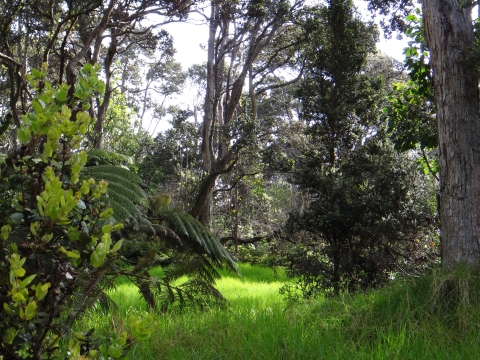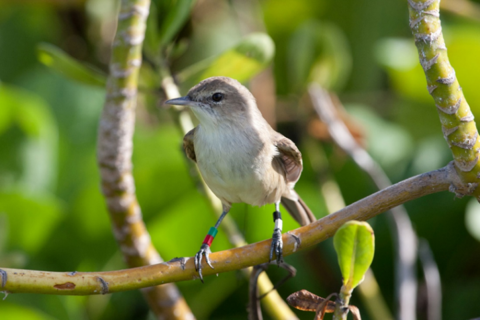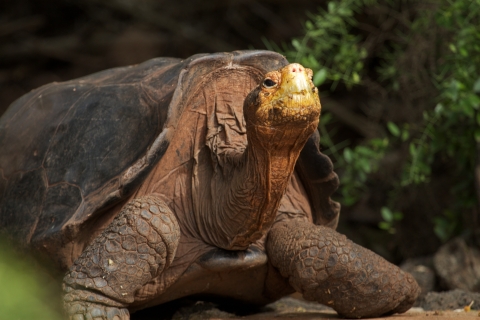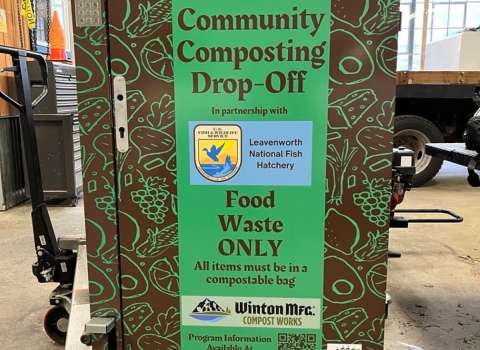Conservation practitioners have numerous tools in their toolbox to help animals and plants survive in their habitats. But what do you do when a species’ habitat is no longer a safe place to live?
For example, ‘Ākohekohe, an endangered native Hawaiian honeycreeper, was once found across the islands of Maui and Molokaʻi in the Hawaiian Archipelago. Now, it is found only within 25 square kilometers on Haleakalā volcano on Maui. Avian malaria, a deadly disease carried by non-native mosquitoes, has restricted its range to areas of only the highest elevations that were too cold for mosquitos to live. As the climate continues to warm allowing mosquitoes to live at higher and higher elevations, safe space from avian malaria for the ‘Ākohekohe is only expected to decrease, putting it at risk of extinction. Avian malaria has already caused the extinction of several native Hawaiian honeycreepers.
“These species evolved without exposure to malaria, so just one bite from an infected mosquito can be fatal. Honeycreepers are being pushed to the limits of their indigenous range, and in some cases there is no longer habitat available without mosquitoes. During recent workshops to address the threat of malaria to Hawaiian forest birds, managers and cultural practitioners identified just a few options to prevent their extinction, including conservation introduction.” said Megan Laut, a U.S. Fish and Wildlife Service Biologist who is involved in the effort to save ‘Ākohekohe.
Conservation introduction as an option
Conservation introduction is the intentional movement and release or outplanting of a species outside its indigenous range for the purpose of conservation. Because ‘Ākohekoke's disease-free habitat is shrinking and likely to vanish, conservation practitioners potentially could move a subset of the population to malaria-free habitat on a different island, such as high elevation areas on Hawaii Island, where the species has never before occurred.
“Populations of several species of Hawaiian honeycreepers are being managed under human care as a means to prevent their extinction. However, managers and cultural practitioners identified conservation introduction as a potentially suitable option for ‘Ākohekohe because its population appears to be large enough to support a potential conservation introduction and because past experience show ‘Ākohekohe is difficult to manage in captivity.” said Laut.
Conservation introduction isn’t a new tool in the conservation practitioner’s toolbox. It has been used to conserve several other species within the Hawaiian Archipelago and beyond. As climate change climate change
Climate change includes both global warming driven by human-induced emissions of greenhouse gases and the resulting large-scale shifts in weather patterns. Though there have been previous periods of climatic change, since the mid-20th century humans have had an unprecedented impact on Earth's climate system and caused change on a global scale.
Learn more about climate change continues to alter species’ habitats and the natural processes on which they depend, consideration of conservation introductions as a strategy for species survival will become more common, and pressing, in the years to come.
But the decision about whether or not to pursue a conservation introduction is a tough one for conservation practitioners to make. There are lot of things to consider and it can carry some serious risks.
“The decision to move a species to a site where it has never occurred is a serious undertaking. We need to consider biological and social risks such as impacts to the source population, impacts to the receiving ecosystem, financial risks, and impacts on people and their livelihoods, lifeways and culture.” said Laut.
A framework to help make transparent, inclusive, and robust decisions
With so much to think about when considering a conservation introduction, the conservation community needed a process to help them through the decision-making process. In response, the U.S. Fish and Wildlife Service (USFWS) developed the Decision Support Framework for Conservation Introductions (framework). The framework serves as a tool to help conservation practitioners make inclusive, transparent, and defensible decisions about when to use conservation introductions as a strategy for one or more of the following reasons:
1. Preventing extinction of a species or extirpation of a population or populations
Example: Endemic to the island of Nihoa, the ulūlu niau (Nihoa millerbird) was at risk of extinction due to a small population size and the increasing threat of hurricanes and invasive species invasive species
An invasive species is any plant or animal that has spread or been introduced into a new area where they are, or could, cause harm to the environment, economy, or human, animal, or plant health. Their unwelcome presence can destroy ecosystems and cost millions of dollars.
Learn more about invasive species . Ulūlu niau were introduced to the island of Laysan (Kamole), over 650 miles away from Nihoa, in 2011 and 2012 to create a second population to reduce its extinction risk and improve its conservation status.
2. Re-establishing an ecological function lost through extinction
Example: The Hood Island Giant Tortoise, native to Española Island (also known as Hood Island) in the Galápagos Islands, was introduced to nearby Santa Fe Island in 2015. The species was introduced to re-establish ecological functions such as grazing, seed dispersal, and the trampling of vegetation which were lost when Santa Fe Island’s endemic tortoise species went extinct more than 150 years prior.
3. Directing ecological change toward a state that better supports conservation goals in an ecosystem undergoing transformation.
Example: Land managers are considering introducing bison at Kenai National Wildlife Refuge in Alaska as grasslands expand in a changing climate. Grazing animals are key to keeping grasslands healthy. Without them, grasslands can become degraded and may stop supporting many plants and animals. Currently, there are no native grazers on the refuge. Bison, which are grazers, could help direct changes on the refuge to support healthy, biodiverse grasslands.
The framework was drafted by a working group of subject matter specialists in the USFWS with feedback from more than 200 people from local, jurisdictional, state, and federal agencies; Tribes; Native Hawaiian organizations; and non-governmental organizations from across the Pacific Northwest and Pacific Islands. The framework also went through peer review by subject-matter experts. The non-regulatory framework is designed to be forward-thinking and inclusive to help the USFWS, partners, and interested parties reach a decision that accounts for the needs of the species, their habitats and ecosystems, and human communities in the face of a changing climate.
The framework was designed specifically for use by the USFWS in the Pacific Region, which serves the Pacific Islands and Pacific Northwest. However, others, such as states, territories, or Tribes considering a conservation introduction, are welcome to use this framework to aid their conservation decisions, whether or not the USFWS is involved.
“While the framework won’t affect decisions we have already made, we are excited that the framework is available to guide us in our future decision making. As the impacts of climate change and other threats increase, the framework will help us make deliberative, inclusive, and transparent decisions.” Laut said.








